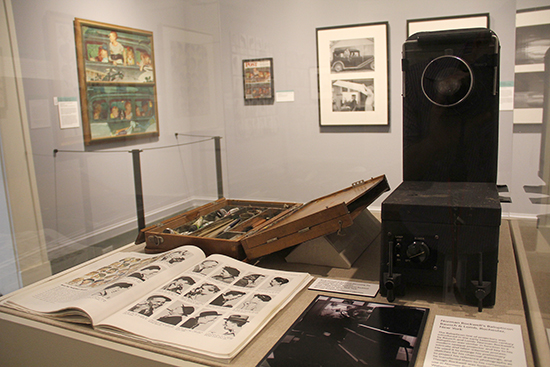Newly Installed Galleries Focus On Key Themes From Artist’s Career; Showcase Rarely Seen Artwork and Objects

Photo of Norman Rockwell Museum’s new process gallery, summer 2015. Photo ©Norman Rockwell Museum. All rights reserved.
Stockbridge, MA, August 7, 2015— During his prosperous six-decade career as an artist, there were several key themes Norman Rockwell (1894-1978) returned to again and again in his paintings. Instantly recognizable, the concepts of humor, heroes, and coming of age were each used by the artist in the service of telling a story through his pictures.
In conjunction with its current exhibition, Roz Chast: Cartoon Memoirs, which also celebrates family, life’s humorous moments, and standing up to adversity, Norman Rockwell Museum will reinstall its main galleries to focus on these thematic elements, and offer an in-depth look at the artist’s process. Norman Rockwell: Heroes, Humor, and Growing Up will be on view at the Museum through October 18, 2015.
The new installation was developed by Jesse Kowalski, Norman Rockwell Museum’s new Curator of Exhibitions. A “lifelong fan” of Rockwell’s work, Mr. Kowalski comes to the Museum this year from The Andy Warhol Museum in Pittsburgh, where he had served as Director of Exhibitions for over a decade. Along with his affinity for the artist, Kowalski also brings a fresh perspective in his curating of the works on view.
Coming of Age
“Many of Rockwell’s most endearing works celebrate the joy of childhood,” notes Kowalski. “Artworks placed in the ‘Coming of Age’ section are presented in chronological order determined by the subjects’ age.” From No Swimming (1921), the newly acquired Boy and Girl Gazing at the Moon (Puppy Love) (1926), Boy in Dining Car (1946), and Girl at Mirror (1951); to Marriage License (1955) and New Kids in the Neighborhood (1967)—artwork in the section features boys and girls enjoying a period of life when days are long and summer seems like it will never end.
Heroes
Known for creating the extraordinary out of the ordinary, Rockwell also developed portraits of some of the most celebrated figures of our time. The “Heroes” section looks at both, and includes such favorites as The Runaway (1958), Portrait of John F. Kennedy (1960), and Lincoln for the Defense (1962); and civil rights era classics, The Problem We All Live With (1963), Murder in Mississippi (1965), and The Peace Corps (JFK’s Bold Legacy) (1966). The artworks in this section include several of the artist’s beloved Boy Scouts paintings. Together, they portray courage in the face of injustice, a desire to help those less fortunate, and recognition of men and women who have fought for freedom.
Humor
Rockwell possessed a keen sense of humor and wit. In fact, he included comical touches in many of his paintings. This section illustrates his ability to connect with American readers through humor, and includes such favorites as Boy with Baby Carriage (1916), Deadline (Artist Facing Blank Canvas) (1938), Before The Shot (1958), Triple Self-Portrait (1960), and the unpublished Marriage Counselor (1963). The section also features several rarely seen charcoal studies, including The Portraitist (early 1950s), Just Married (1957) and Waiting for the Art Editor (1960). Murder Mystery (1948) is also on view, along with reference photos of such actors as Ethel Barrymore, Boris Karloff, and Lassie, who appeared in the never published who-dunnit illustration. Rockwell’s 1955 illustration Mermaid is represented with a charcoal study, as well as correspondence from such organizations as the Society for the Prevention of Cruelty to Mermaids.
Process
The installation also explores Norman Rockwell’s process—through the use of costumes, props, and models in directing scenes for photography, subsequent sketches and oil studies, and the completed painting, which is exhibited alongside its published illustration. From preliminary idea to final painting, the section focuses on Rockwell’s classic Saturday Evening Post covers, Going and Coming (1947), The Gossips (1948), and Art Critic (1955). Also included in the gallery are the artist’s travel paint box and brushes, and his Balopticon, which, through the use of photographic projection, aided Rockwell in realizing his artistic vision.
The works in this new display reflect Norman Rockwell’s desire to “paint life as I would like it to be.” Also on exhibit at the Museum are a full set of Rockwell’s 323 Saturday Evening Post cover tear sheets, and an installation of his original Stockbridge studio circa 1960, when he was working on the Golden Rule painting. All three exhibitions will be on view through October 2015.
Roz Chast: Cartoon Memoirs
On view through October 26, 2015
Over the past 37 years, readers of The New Yorker have been enjoying cartoonist Roz Chast’s signature style and wit. From her timelessly funny cartoons and lively children’s picture books, to her intricately-painted pysanka eggs and hand-made textiles, Roz Chast: Cartoon Memoirs will feature works representing the breadth of Chast’s entire artistic career. A highlight of the exhibition will be nearly 120 original drawings from her award-winning memoir, Can’t We Talk About Something More Pleasant? which tackles the sensitive subject of caring for the elderly, with thoughtful insight and humor.

